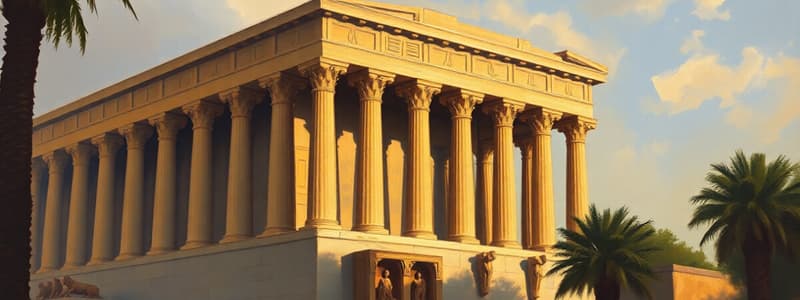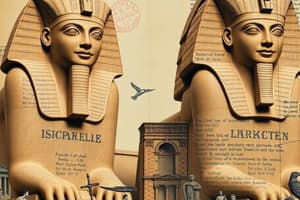Podcast
Questions and Answers
La escultura egipcia se caracterizaba por su realismo y se utilizaba a menudo con fines funerarios.
La escultura egipcia se caracterizaba por su realismo y se utilizaba a menudo con fines funerarios.
True (A)
¿Cuál de las siguientes opciones NO es un material utilizado en la escultura egipcia?
¿Cuál de las siguientes opciones NO es un material utilizado en la escultura egipcia?
- Cerámica (correct)
- Metal
- Piedra
- Madera
Las estatuas egipcias suelen representarse en una posición frontal, con rasgos estilizados.
Las estatuas egipcias suelen representarse en una posición frontal, con rasgos estilizados.
True (A)
Los retratos en la escultura egipcia se caracterizan por la falta de precisión y una expresión rígida.
Los retratos en la escultura egipcia se caracterizan por la falta de precisión y una expresión rígida.
¿Qué significado simbólico tenían las esculturas egipcias?
¿Qué significado simbólico tenían las esculturas egipcias?
¿Qué función tenían los templos egipcios?
¿Qué función tenían los templos egipcios?
Los templos egipcios se diseñaron para ser simples y acogedores.
Los templos egipcios se diseñaron para ser simples y acogedores.
¿Con qué materiales se construyeron los templos egipcios?
¿Con qué materiales se construyeron los templos egipcios?
¿Cuáles son algunas de las características de diseño que se encuentran comúnmente en los templos egipcios?
¿Cuáles son algunas de las características de diseño que se encuentran comúnmente en los templos egipcios?
Los templos egipcios estaban orientados de manera aleatoria.
Los templos egipcios estaban orientados de manera aleatoria.
Los jeroglíficos y los relieves en los templos eran meramente decorativos.
Los jeroglíficos y los relieves en los templos eran meramente decorativos.
Los complejos de templos egipcios se construían sin tener en cuenta el entorno natural.
Los complejos de templos egipcios se construían sin tener en cuenta el entorno natural.
Todos los templos egipcios estaban dedicados a los mismos dioses.
Todos los templos egipcios estaban dedicados a los mismos dioses.
Los murales egipcios representan escenas solo de la vida religiosa.
Los murales egipcios representan escenas solo de la vida religiosa.
Los colores utilizados en los murales egipcios se usaban aleatoriamente para decorar.
Los colores utilizados en los murales egipcios se usaban aleatoriamente para decorar.
Las figuras en los murales egipcios se representan con un estilo realista.
Las figuras en los murales egipcios se representan con un estilo realista.
Los pigmentos utilizados para pintar los murales egipcios no eran duraderos.
Los pigmentos utilizados para pintar los murales egipcios no eran duraderos.
Los pintores egipcios utilizaban la perspectiva de manera similar a los artistas occidentales.
Los pintores egipcios utilizaban la perspectiva de manera similar a los artistas occidentales.
El estilo de los murales egipcios permaneció sin cambios a lo largo del tiempo.
El estilo de los murales egipcios permaneció sin cambios a lo largo del tiempo.
El arte funerario egipcio tenía como objetivo garantizar el bienestar del difunto en la vida terrenal.
El arte funerario egipcio tenía como objetivo garantizar el bienestar del difunto en la vida terrenal.
¿Cuáles de las siguientes son formas de arte funerario egipcio?
¿Cuáles de las siguientes son formas de arte funerario egipcio?
Los bienes funerarios se incluían en las tumbas solo para fines decorativos.
Los bienes funerarios se incluían en las tumbas solo para fines decorativos.
Las tumbas egipcias reflejaban el estatus social del difunto, y las más elaboradas indicaban un estatus social más bajo.
Las tumbas egipcias reflejaban el estatus social del difunto, y las más elaboradas indicaban un estatus social más bajo.
Las decoraciones en las tumbas y los sarcófagos representaban escenas solo de la vida religiosa.
Las decoraciones en las tumbas y los sarcófagos representaban escenas solo de la vida religiosa.
La creencia en la continuación de la vida después de la muerte no tuvo un impacto en las prácticas funerarias egipcias.
La creencia en la continuación de la vida después de la muerte no tuvo un impacto en las prácticas funerarias egipcias.
La momificación era una práctica poco común en los entierros egipcios.
La momificación era una práctica poco común en los entierros egipcios.
La construcción de pirámides era un símbolo de la devoción y la creencia en la vida después de la muerte.
La construcción de pirámides era un símbolo de la devoción y la creencia en la vida después de la muerte.
Flashcards
Escultura egipcia
Escultura egipcia
La escultura egipcia se caracterizó por el realismo y su función funeraria.
Materiales escultóricos
Materiales escultóricos
Piedra (granito, basalto, caliza) fueron los materiales preferidos para esculpir.
Posición de las figuras
Posición de las figuras
Las figuras esculpidas usualmente estaban en postura frontal con rasgos estilzados.
Retratos egipcios
Retratos egipcios
Signup and view all the flashcards
Proporciones idealizadas
Proporciones idealizadas
Signup and view all the flashcards
Significados simbólicos
Significados simbólicos
Signup and view all the flashcards
Estatuas faraónicas colosales
Estatuas faraónicas colosales
Signup and view all the flashcards
Templos egipcios
Templos egipcios
Signup and view all the flashcards
Materiales de construcción
Materiales de construcción
Signup and view all the flashcards
Pilares, patios e interiores sagrados
Pilares, patios e interiores sagrados
Signup and view all the flashcards
Orientación astronómica
Orientación astronómica
Signup and view all the flashcards
Jeroglíficos y bajorrelieves
Jeroglíficos y bajorrelieves
Signup and view all the flashcards
Planificación armoniosa
Planificación armoniosa
Signup and view all the flashcards
Tipos de templos
Tipos de templos
Signup and view all the flashcards
Pinturas murales egipcias
Pinturas murales egipcias
Signup and view all the flashcards
Colores simbólicos
Colores simbólicos
Signup and view all the flashcards
Representaciones estilizadas
Representaciones estilizadas
Signup and view all the flashcards
Pigmentos naturales
Pigmentos naturales
Signup and view all the flashcards
Perspectiva limitada
Perspectiva limitada
Signup and view all the flashcards
Arte funerario egipcio
Arte funerario egipcio
Signup and view all the flashcards
Tumbas y sarcófagos
Tumbas y sarcófagos
Signup and view all the flashcards
Bienes en la tumba
Bienes en la tumba
Signup and view all the flashcards
Estatus social en tumbas
Estatus social en tumbas
Signup and view all the flashcards
Decoraciones en tumbas
Decoraciones en tumbas
Signup and view all the flashcards
Momificación
Momificación
Signup and view all the flashcards
Pirámides
Pirámides
Signup and view all the flashcards
Study Notes
Escultura Egipcia
- Egyptian sculpture emphasized realism and was often used for funerary purposes.
- Statues were typically made of durable materials like stone (granite, basalt, limestone).
- Figures were often portrayed in a frontal stance, with stylized features.
- Portraits conveyed accuracy and a serene expression.
- A significant style feature was the use of idealized proportions, creating a sense of balance and harmony.
- Often, sculptures had symbolic meanings relating to the deceased or their status in life.
- Colossal statues of pharaohs were erected to showcase royal power and legacy.
Arquitectura De Templos
-
Egyptian temples were elaborate structures that served religious and political purposes.
-
They were designed to be awe-inspiring and reflect the power and divinity of the pharaohs.
-
Primary construction materials included stone, brick, and timber.
-
The design often featured monumental gateways (pylons), courtyards, and inner sanctuaries.
-
Temples were oriented towards specific astronomical events, demonstrating a deep understanding of celestial mechanics in architectural planning.
-
Hieroglyphs and bas-relief carvings often adorned temples, creating vivid narratives about the gods, pharaohs, and rituals.
-
Temple complexes were carefully planned to be harmonious with natural features.
-
Different temple types were built to honor specific deities. For example, some temples were highly decorated, while others emphasized practical aspects of worship.
Pintura Mural
- Egyptian murals frequently depicted scenes from daily life, religious rituals, and historical events.
- Colors were vibrant and symbolic, often representing the gods, the natural world, or specific social statuses.
- Figures were depicted in a stylized manner, with emphasis on profile views and frontal views for parts of the body.
- Paints were made from naturally occurring pigments, which gave the murals a remarkable durability.
- The use of perspective was limited in ancient Egyptian painting, with images arranged in horizontal registers.
- The style varied over time and across regions. Some murals had detailed narrative sequences.
Arte Funerario
- Egyptian funerary art aimed to ensure the deceased's well-being in the afterlife.
- It included elaborate tombs, sarcophagi, and various grave goods.
- The elaborate tomb construction and grave goods were thought to provide the deceased with everything needed in the afterlife—food, clothing, tools, and entertainment.
- Tombs reflected the social status of the deceased, with more elaborate designs indicating higher social standing.
- Decorations in tombs and sarcophagi often depicted scenes of daily life to help the deceased in the afterlife.
- The belief in a continuation of life after death inspired the creation of elaborate burial rituals and practices.
- Mummification procedures were a critical part of Egyptian funerary practices.
- The construction of pyramids was a testament to the devotion and belief in the afterlife, with the pharaohs believing their constructions were part of their rebirth or eternal residence.
Studying That Suits You
Use AI to generate personalized quizzes and flashcards to suit your learning preferences.
Description
Este cuestionario explora dos aspectos importantes de la cultura egipcia: la escultura y la arquitectura de templos. Analiza cómo la escultura reflejaba la realidad y el estatus, mientras que los templos eran ejemplos de poder y devoción. Descubre los materiales utilizados y las características clave de estas obras maestras.




